Regulating and monitoring British Columbia's shellfish aquaculture facilities 2019
Introduction
Purpose
This report, Regulating and Monitoring British Columbia's Shellfish Aquaculture Facilities, provides an overview of the shellfish aquaculture industry in British Columbia, with a focus on Fisheries and Oceans Canada's (DFO) regulatory activities and the environmental and operational performance of the industry. Key issues facing the industry, topics for education, outreach, and engagement activities, an assessment of compliance with regulatory and administrative requirements, enforcement measures, areas for improvement, and grants and contribution programs are also highlighted.
DFO intends to produce this publication on an annual basis to enhance transparency around regulation of shellfish aquaculture. This publication also aims to increase the amount of information available to the public on the sector's performance as part of the Department's commitment to ensuring a sustainable, world-class aquaculture industry in Canada. Additional information regarding regulation of the shellfish aquaculture industry in BC can be found on our aquaculture website and on the Government of Canada's Open Data portal.
Executive summary
The shellfish aquaculture industry is important to British Columbia's economy. In 2019, the sector produced a landed value of approximately $27 million. The majority of shellfish aquaculture activity occurs along the southern coast of BC around Vancouver Island, with large concentrations in Baynes Sound and near the northern Gulf Islands.
Fisheries and Oceans Canada (DFO) is the lead regulatory authority for aquaculture operations in BC. DFO works in partnership with other federal government departments, such as Transport Canada (TC), the Canadian Food and Inspection Agency (CFIA), Environment and Climate Change Canada (ECCC), as well as with the Province of BC to manage and support a sustainable shellfish aquaculture industry. The Shellfish Integrated Management of Aquaculture Plan, outlines the management framework for shellfish aquaculture in BC and aims to protect fish and fish habitat and ensure the health and safety of Canadians through food safety protocols.
DFO assesses compliance of the shellfish aquaculture industry by conducting on-site inspections of facilities and audits of reporting and record keeping requirements. In 2019, DFO initiated an audit of 2017/18 record keeping by licensed aquaculture facilities and found that 31% did not meet the requirements. The audit also identified other compliance concerns and resulted in 11 files being referred to DFO's Conservation and Protection (C&P) fishery officers for enforcement action and the detection of 21 violations.
Key issues facing the BC shellfish industry in 2019 were traceability, norovirus outbreaks, and debris management. DFO is committed to collaborating with its partners, First Nations, and stakeholders to ensure the safe harvest of shellfish products and to protect the marine environment from aquaculture related debris.
Bivalve shellfish, such as clams and oysters, are affected by changing ocean conditions and susceptible to accumulation of contaminants including viruses, bacteria, and toxins. DFO engages with multiple regulatory bodies on shellfish safety through the Canadian Shellfish Sanitation Program (CSSP) to ensure that shellfish harvested from BC waters are safe for consumption. Significant norovirus outbreaks connected to the BC shellfish and herring industries occurred in 2017 and 2018, prompting an action plan for minimizing outbreaks. In 2019, there were no norovirus outbreaks attributed to the consumption of raw oysters harvested from BC.
In recent years, the presence of marine debris, including derelict gear, unmaintained infrastructure, and improperly wrapped or exposed foam, has been linked to shellfish aquaculture activities in BC. DFO is pursuing increased compliance through a variety of enforcement and licensing tools and is prioritizing management of this issue to help meet the Government of Canada's goal of zero plastic waste in the oceans.
Through education and outreach, compliance and enforcement, and regulatory and/or policy changes, it is anticipated that these food safety and environmental challenges will be addressed.
Industry overview
In BC, the aquaculture industry is primarily regulated and managed by Fisheries and Oceans Canada (DFO). DFO became the lead agency and began licensing aquaculture facilities in BC in December 2010. Aquaculture licences are issued under the authority of the Fisheries Act and the Pacific Aquaculture Regulations (PAR). These licences confer the authority to carry out aquaculture activities, including the cultivation and harvest of fish and include prescribed activities under conditions of licence. Key responsibilities of DFO staff include:
- developing shellfish aquaculture conditions of licence
- reviewing applications and issuing aquaculture licences
- ensuring compliance with shellfish aquaculture conditions of licence and the Fisheries Act
- issuing additional authorizations required for aquaculture operations including:
- Management of Contaminated Fisheries Regulations (MCFR) licences,
- Access to Wild Aquatic Resources licences, and
- Introductions and Transfers licences
- consulting with First Nations, industry, and stakeholders; and
- providing operational and policy support for the Canadian Shellfish Sanitation Program (CSSP).
As the provincial government continues to play a role in managing aquaculture tenures in BC, DFO staff work closely with provincial counterparts to review applications for new aquaculture sites and activities through a harmonized licensing process. Applications currently under review by the Department are available on our website. If applications are approved, details are added to the list of current shellfish aquaculture licence holders: Current valid British Columbia aquaculture licence holders - Open Government Portal (canada.ca). Processors refer to this list to ensure that they are purchasing shellfish from a safe, legal source.
In 2019 there were 480 licensed shellfish aquaculture facilities. Overall production was 9,700 tonnes with a landed value of $27 million, compared to 8,900 tonnes worth $23 million in 2018. The Pacific oyster is the most widely cultivated shellfish species in BC accounting for approximately 56% of market sales, followed by clams, mussels, and scallops (Figure 1).
Long text version
Production by dollar value
| Mussels | 15% | $4.15M |
| Clams | 26% | $6.97M |
| Scallops | 2% | $0.63M |
| Oyster | 56% | $15.25M |
Production by weight
| Mussels | 7.5% |
| Clams | 11.5% |
| Scallops | 0.8% |
| Oyster | 80.2% |
Species cultured in British Columbia
The commercial culture of Pacific oysters in BC can be traced back to 1912 when the species was first introduced from Japan. Since then, other species such as Kumamoto oysters, European oysters, Manila clams, Gallo mussels, Japanese scallops, and the native weathervane scallop/Japanese scallop hybrid have been added to the inventory of shellfish species cultured in BC. In addition, a number of native shellfish species are also cultured, including littleneck clams, Western blue mussels, and geoduck clams.
Shellfish culturists rely on access to healthy seed (juvenile shellfish) stock for grow-out operations. While some culturists use naturally set seed, in general, most seeds are produced at shellfish hatcheries where mature adults are spawned and their progeny reared to a size suitable for out- planting. Presently there are only a few shellfish hatcheries in BC that are equipped to provide seed of various species. Almost 90% of the seed supply for the major species (oysters, Manila clams, scallops, and mussels) are imported from certified hatcheries in other countries, such as the USA and Chile.
To prevent inadvertent disease transfer and potential negative impacts on native stock genetics and ecosystems, the Fishery (General) Regulations (FGR) prohibit the introduction and transfer of fish and shellfish into fish habitat or fish-rearing facilities without a licence. DFO reviews and approves all introduction and transfer requests according to the National Code on Introductions and Transfers of Aquatic Organisms and section 56 of the FGR. This regulatory process ensures that all shellfish movements are done in a safe and responsible manner to protect wild fish and fish habitat.
Locations of shellfish aquaculture facilities
Shellfish aquaculture is generally concentrated in areas around the southern coast of BC, including the west coast of Vancouver Island and the Georgia Basin (particularly Baynes Sound, Cortes Island, and Okeover Inlet). There are also a small number of farms located in the North Coast, near Haida Gwaii and Prince Rupert. Shellfish can only be legally harvested from areas where water quality has been assessed by Environment and Climate Change Canada (ECCC) and deemed to be suitable for growing shellfish that are safe for human consumption. There is considerable First Nation interest in the expansion of shellfish aquaculture in areas of the North and Central Coast, but opportunities are limited by a lack of water quality monitoring in these more remote areas.
Licensed shellfish aquaculture facilities as of December 31, 2019 are shown in Figure 2.
An updated version of this map is also available on our website.
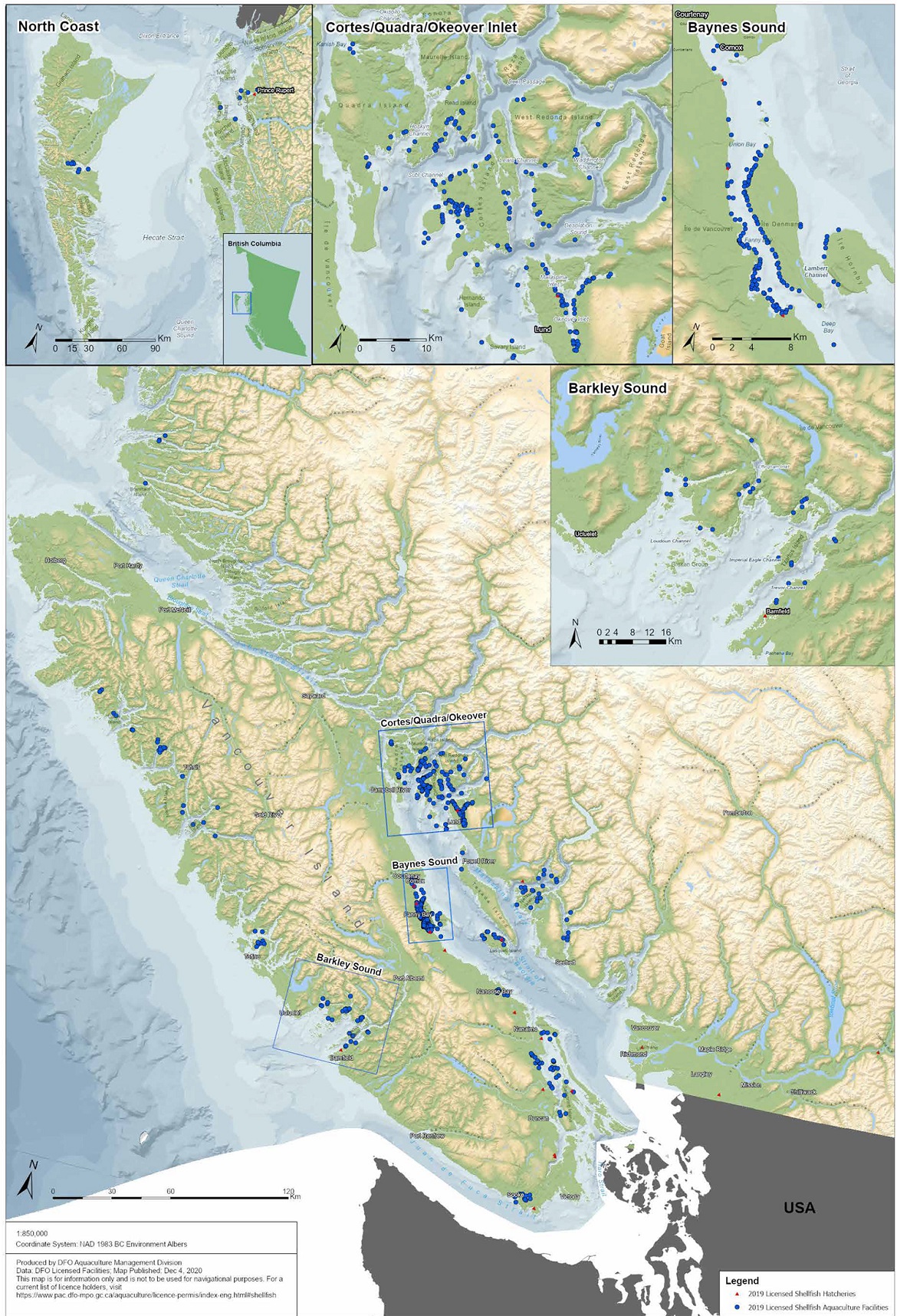
Long text version
Scale is 1:185,000
Coordinate System: NAD 1983 BC Environment Albers
Produced by DFO Aquaculture Management Division
Data: DFO licensed facilities; map published: Dec 4, 2020
This map is for information only and is not to be used for navigational purposes.
For a current list of licence holders, visit the Open Data record called: Current valid British Columbia aquaculture licence holders.
Regulating
Roles of DFO and other agencies
While Fisheries and Oceans Canada (DFO) is the lead authority for regulating aquaculture in BC, other federal departments and provincial agencies have roles in the management and regulation of the industry. For example, Transport Canada (TC) is responsible for reviewing applications with respect to the protection of navigable waters and the Canadian Food Inspection Agency (CFIA) has jurisdiction related to aspects of shellfish sanitation, fish health and processing, and health risks associated with the consumption of shellfish.
The Province of BC remains responsible for authorizing the occupation of provincial aquatic Crown land associated with aquaculture operations and ensuring the tenures are kept clean, safe, and sanitary. Aquatic Crown land refers to land below the visible high tide water-mark, extending offshore to the recognized limit of provincial jurisdiction, including the foreshore. In some cases, municipal zoning, administered by local governments, also applies in marine and foreshore areas.
Assessing applications and environmental considerations
DFO is responsible for ensuring that the shellfish aquaculture industry operates sustainably. Similar to other development activities occurring in and around water, aquaculture projects have the potential to negatively impact fish and fish habitat. Therefore, DFO reviews all new aquaculture applications and amendments. Applicants must determine and disclose whether the site is to be located in ecologically sensitive areas, as well as self assess for potential impacts to species listed under the Species at Risk Act, or their critical habitats. Departmental biologists evaluate, verify, and audit applications based on available information on fish habitats, wild fisheries, and conduct site visits as needed. In some cases, the applicant must submit fish habitat surveys conducted by a qualified environmental professional. Should a review identify unacceptable risk of harm to sensitive or important habitats or fish species, applicants are required to employ mitigation measures. If the risk cannot be adequately mitigated, the application is rejected.
If licensed, an aquaculture facility is subject to licence conditions that ensure the proper management of aquaculture activities including:
- movements of fish between sites
- escapes, predator control, and incidental catch mitigation
- protection of fish habitat and appropriate management of debris
- harvest and handling requirements including food safety controls
- measures to prevent the spread of Aquatic Invasive Species
- onboard waste containment requirements
- record keeping requirements; and
- species- or site-specific conditions
Current shellfish aquaculture conditions of licence are available online.
Shellfish Integrated Management of Aquaculture Plan
The Shellfish Integrated Management of Aquaculture Plan (SF-IMAP) outlines the management framework for shellfish aquaculture in BC within marine waters. In some cases, the process of culturing shellfish throughout a life cycle may fall under more than one IMAP (e.g., shellfish and land-based). This includes scenarios where shellfish may be spawned and reared in land-based hatcheries at some stage of their life cycle prior to transfer to the marine environment.
Consistent with the management of other fisheries, DFO has established advisory processes to support the development of IMAPs, as well as broaden engagement with First Nations, industry, and stakeholders regarding the management of aquaculture in BC. The Shellfish Aquaculture Management Advisory Committee (SF-AMAC) is comprised of First Nations, shellfish aquaculture licence holders, industry associations, environmental interest groups, and local government representatives.
The SF-IMAP is available for download online.
Key issues in shellfish aquaculture
Aquaculture is an evolving industry, and because of this, emerging issues can be uncovered that require action from Fisheries and Oceans Canada (DFO), industry, and other regulatory bodies. In 2019, key issues that DFO undertook and monitored included shellfish safety and traceability of bivalves, environmental debris, summer mortalities, aquatic invasive species, and climate change.
Shellfish safety, outbreaks, and traceability in British Columbia
As filter feeders, bivalve shellfish are susceptible to accumulating contaminants, viruses, bacteria, and toxins. Health and safety risks around consumption of bivalves are increased when they are harvested from environments that are contaminated. The consumption of contaminated bivalves can result in varying levels of illness and even death, depending on the nature of the contamination. The widespread consumption of raw shellfish, particularly oysters, increases this risk as the heat of cooking can kill many (but not all) viruses and bacteria. DFO and other federal partners, along with the industry, have taken steps to monitor and implement practices to minimize risks associated with contaminated shellfish.
Canadian Shellfish Sanitation Program
DFO works with multiple regulatory bodies on shellfish safety. The Canadian Shellfish Sanitation Program (CSSP) is a national food safety program designed to minimize the health risks associated with the consumption of contaminated shellfish.
The Canadian Food and Inspection Agency (CFIA) leads the coordination of the CSSP and is responsible for the control of handling, storage, transportation, processing, and labelling of shellfish (including imports). The CFIA also coordinates the Marine Biotoxin Control Program under the Fisheries Act and Regulations and it liaises with foreign governments on matters relevant to shellfish sanitation and international trade.
Environment and Climate Change Canada (ECCC) is responsible for monitoring of water quality in shellfish harvest areas through their biotoxin surveillance program. They identify and evaluate contamination sources and recommend to DFO the closure and reopening of shellfish harvest areas based on Canadian marine water quality standards.
DFO is responsible for the enforcement of closure regulations and enacting the shellfish fishery openings and closings in areas under the authority of the Fisheries Act, as defined in the Management of Contaminated Fisheries Regulations (MCFR), and as recommended by CSSP program partners, ECCC and CFIA. A real-time map of shellfish harvest area closures can be found here.
DFO is also responsible for the control of shellfish harvests until the product enters a federally registered processing facility. Licences to harvest shellfish in marginally contaminated areas are issued under authority of the MCFR for both vacant Crown foreshore and aquaculture facilities. Shellfish fisheries in contaminated areas have been licensed by DFO since the 1990s, in accordance with policies set out in the CSSP. Prior to processing for human consumption, these shellfish must be cleansed, either by relay (moving to an approved area) or by depuration (placing in a tank of clean water in a processing facility) for a minimum prescribed time. Prior to issuance of a MCFR licence, a decontamination plan must be approved by both CFIA and DFO.
The CSSP is subject to external audit and scrutiny from countries receiving shellfish exports from Canada. For example, the United States Food and Drug Administration (USFDA) conducts full audits of Canadian growing areas, processing facilities, waste treatment plants, and laboratories involved in testing shellfish every three years. Elements of the audit include compliance with aquaculture licence conditions, traceability of product, and other harvest controls under the CSSP. Significant illness outbreaks, uncertainty regarding handling and control of harvested product, or product traceability may threaten bivalve shellfish exports to the USA or other countries. This would result in significant economic impacts to the shellfish industry nation-wide and negatively impact Canada's reputation as a trade partner.
Pacific Aquaculture Regulations (PAR) licence conditions pertaining to the CSSP and control of harvest include tagging, record keeping, statistical reporting, requirement to land at a federally registered processing facility, product handing controls, and controls around floating living accommodations and collection of seed in prohibited areas.
Norovirus outbreaks
One of DFO's priorities for 2019 was to minimize the potential for an outbreak of norovirus, a highly contagious virus that can be transmitted through the consumption of contaminated raw oysters.Norovirus particles can accumulate and persist in shellfish in the marine environment, which can lead to outbreaks of illness if contaminated shellfish are marketed and consumed.
In 2018, there was a norovirus outbreak attributed to the consumption of contaminated raw oyster harvested from the Baynes Sound area. A foodborne illness outbreak investigation, led by the Public Health Agency of Canada, indicated that the contamination was likely associated with discharge from vessels participating in the Strait of Georgia's herring roe fishery. More than 200 norovirus cases were reported with more than 100 cases occurring in the United States, Canada's leading destination for exported oysters. Consequently, the State of California issued a warning to not consume shellfish from BC, which impacted Canada's reputation as having safe and high quality products. This resulted in loss of consumer confidence and loss of community identity in areas where shellfish growing is prevalent.
Food-borne illness outbreaks in BC, including both Vibrio parahaemolyticus and norovirus, attributed to consumption of raw or undercooked oysters not only have the potential to cause serious reputational damage to Canadian shellfish product and to limit access to export markets, but also result in significant economic losses. The coast-wide norovirus outbreak in 2017 resulted in an estimated loss to oyster growers in BC of $9 million.
In an effort to minimize the risk of norovirus outbreaks, DFO has led engagement with the British Columbia Shellfish Growers Association (BCSGA), the herring fishery industry, BC Ministry of Agriculture, CFIA, ECCC and TC, as well as the shellfish aquaculture industries. The collaboration aims to share interests and jurisdictional authorities, as they relate to vessel discharge, and produce an action plan for minimizing the risk of future outbreaks. Efforts focus on education, outreach, management, and enforcement opportunities.
There were no norovirus outbreaks attributed to the consumption of raw oysters harvested from BC in 2019.
Bivalve traceability
Bivalve traceability is the ability to trace shellfish aquaculture products back to their source. In some cases it is interpreted as the ability to verify the history, location, or application of an item by means of recorded identification. Uncertainties in traceability can have significant impacts on domestic and international export markets because of the weakened control of harvested product and the potential for contaminated product to enter the food market. A number of marine shellfish aquaculture licence conditions pertain to traceability of product, including seeding activities, movements of product during the growing cycle, and harvest of product to the point of landing. Traceability and assurance of the legal harvest of licensed cultivated product is critical for a number of reasons including:
- human public health and safety (under the CSSP)
- protection of wild shellfish populations; and
- economic considerations, including maintaining international export markets
Aquaculture debris
Each year, more than eight million metric tons of plastic end up in the world's oceans. Plastic debris can have negative impacts on wild and cultured shellfish through the potential introduction of aquatic invasive species, harmful algal blooms, pathogens leading to disease, ingestion of plastics, entanglement, and absorption of chemicals by shellfish destined for human consumption. Marine debris originates from a variety of sources including, but not limited to, the shellfish aquaculture industry. Abandoned, lost, or discarded fishing and aquaculture gear (also known as ghost fishing gear) is a major contributor to plastic marine debris. Examples from aquaculture activities include derelict gear, unmaintained infrastructure, improperly wrapped or exposed foam, and errant netting. As part of our G7 Presidency in 2018, Canada led the development of the Ocean Plastics Charter, an international effort to reduce plastics in our oceans.
View the Ocean Plastics Charter.
Marine debris and abandoned gear is a significant environmental impact of the shellfish aquaculture sector in BC. Licence conditions require licence holders to protect fish and fish habitat by taking measures to remove end of life infrastructure and refuse from the marine environment. DFO has received numerous and ongoing complaints from local residents and environmental groups in areas where shellfish aquaculture activities are concentrated, citing poorly maintained or derelict gear from farms.
In 2019, the majority of aquaculture related reports received via the DFO Observe, Record, Reporting hotline continued to be related to debris issues associated with the shellfish industry.
Nanoose Beach clean-Up
DFO's Aquaculture Management Division organized a beach clean-up of Nanoose Bay on Sept 26th, 2019 (Figure 3). The BCSGA, local shellfish growers, and the Snaw-naw-as (Nanoose First Nation) came together on the beach to remove 500kg of debris, primarily mixed plastics and chunks of foam.
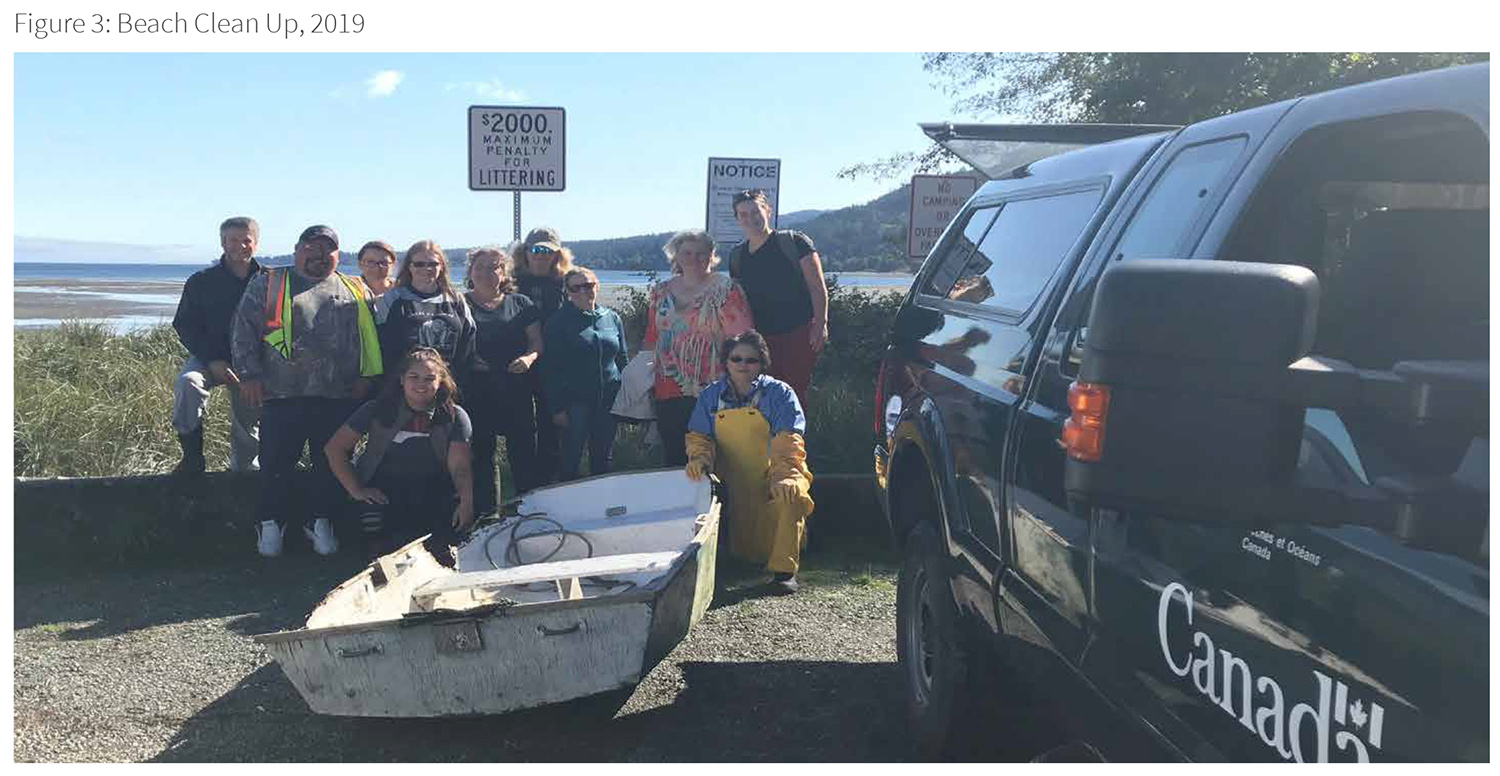
Summer mortalities
Pacific oysters (Crassostrea gigas) have been cultivated in BC for over a century and account for the majority of shellfish cultured in the province. Over the last decade, cultured Pacific oysters throughout the province have been subject to periodic mass mortalities, ranging from at least 30% to near total loss, during the summer months. Summer mortality in Pacific oysters from temperate climates in other parts of the world has been associated with a number of physical and biological factors, including elevated water temperatures, age class, reproductive state, low salinity events, harmful algal blooms, and pathogenic bacteria. On-going field research by DFO Science has confirmed that oyster summer mortality in BC, like in other regions, is correlated with high seawater temperatures, increased reproductive effort, and the presence of a pathogenic bacterium (Vibrio aestuarianus). Results of this work will be published in 2020/2021.
Aquatic invasive species
As with many other marine vectors including commercial shipping and recreational boating, shellfish aquaculture has the potential to propagate the spread of Aquatic Invasive Species (AIS). The introduction of gear and product to the marine environment can increase available habitat for a number of AIS, including biofouling species, like various tunicate and bryozoan species, and European green crab. Aquaculture-related movements have contributed to the spread of AIS. This is a concern as AIS are a major driver of ecosystem change that can reduce biodiversity, alter community structure and function, diminish fisheries and aquaculture production, and impact human health and well-being.
Currently, five high-risk marine species, listed under the control schedule in the AIS regulations in the Fisheries Act, are present in BC:
- violet tunicate (Botrylloides violaceus)
- golden star tunicate (Botryllus schlosseri)
- club tunicate (Styela clava)
- carpet sea squirt (Didemnum vexillum); and
- European green crab (Carcinus maenas)
Each of these species has the potential to be translocated with shellfish and gear movements. Furthermore, there are other AIS of concern and the potential for new AIS to be detected. Reports from industry or the public can help refine the knowledge base of AIS distributions in BC. DFO may impose regulations to constrain the distribution of these species, such as restricting movement of gear or product from areas where AIS are known to exist, removal of AIS from product prior to movement (through manual, biological, or chemical means), or instituting measures to ensure that potential AIS hitchhikers cannot escape into receiving waters. In 2020, DFO Science will be concluding a multi-year study on the effectiveness of pressure washing to remove AIS from cultured oysters, which will help inform DFO Aquaculture Management about the efficacy of this AIS mitigation measure.
Climate change and changing ocean conditions
The economic sustainability of shellfish aquaculture operations is contingent on minimizing risks from our changing climate. Evaluating these risks is complex and some culture methods may be impacted more than others. Aquaculture infrastructure may be damaged by increased storm frequency and intensity, and rising water temperatures may affect the growth of cultured shellfish resulting in reduced resistance to diseases.
Shellfish aquaculture facilities in BC have experienced the effects of ocean acidification, which occurs when the availability of minerals (aragonite and calcium carbonate) is reduced. This results in poor shell formation, poor health, reduced growth, and ultimately a lower quality product. Scientists are working to better understand the process of ocean acidification and it's impacts. In 2017, DFO and the US National Oceanographic and Atmospheric Administration 13 (NOAA) began collaboration on research in Canada and the USA to identify the impacts on cultured species. In addition, DFO and the shellfish industry in BC are working together through the Aquaculture Collaborative Research and Development Program (ACRDP) on a number of research projects related to understanding the current and future effects of ocean acidification and warming on shellfish aquaculture.
Education, outreach, and engagement
Fisheries and Oceans Canada (DFO) consults with First Nations, stakeholders, and Canadians on matters of interest and concern. Consultation and engagement play important roles in good governance, sound policy development, and decision making. Our goal is to promote compliance through strategies such as education, promotional campaigns, and engagement of partners and stakeholders. Educational activities are intended to raise awareness and understanding resulting in more informed public and resource users, and improving the licence holder's ability to comply with regulatory requirements. A number of activities specific to shellfish aquaculture were undertaken in 2019 (Table 1). These public events included the BC Seafood Expo and communication of key topics to the shellfish industry through fishery notices and letters to licence holders. Fishery notices can be found on our webpage. In addition, DFO established advisory processes for shellfish aquaculture including:
- The Shellfish Aquaculture Industry Advisory Panel (SAIAP), a formal consultation process between DFO and industry to ensure regular communications on major policy, research, and regulatory issues, as well as updates from industry on their priorities and business realities; and
- The Shellfish Aquaculture Management Advisory Committee (SF-AMAC), a multi- stakeholder forum tasked with providing feedback to DFO on the coast-wide management of shellfish aquaculture and the development of the Shellfish Integrated Management of Aquaculture Plan (SF-IMAP). Further information on the SF-AMAC, including the terms of reference and the SF-IMAP is available on our consultation webpage.
| Key topic | Delivery mechanism |
|---|---|
| National Aquaculture Act |
|
| National Precautionary Approach/ Framework for Aquaculture Risk Management |
|
| Bivalve Traceability – including traceability conditions of licence, tagging, Annual Aquaculture Statistical Reports (AASR), audits of record keeping requirements and Bivalve Traceability Action Plan |
|
| Canadian Shellfish Sanitation Program Updates |
|
| Vessel Discharge Working Group/ Herring-Norovirus Action Plan |
|
| Requirements for Wet Storage of Harvested Product |
|
| Integrated Environmental Compliance – including Debris Action Plan, Nanoose Bay Beach Clean Up,) |
|
| Marine Mammal Deterrents |
|
| Access to Wild Resources – Collection of Wild Oyster Spat |
|
| Shellfish Aquaculture Science |
|
| Area Based Management |
|
| 2018 Shellfish Annual Report |
|
| DFO Aquaculture Management Priorities |
|
Assessing compliance
To help inform management decisions, Fisheries and Oceans Canada (DFO) assess compliance with regulations and other requirements, such as record keeping and reporting, and the payment of fees with regulations through site inspections, record keeping audits, industry required notifications and reporting, and payment of licence fees. Identification of compliance issues can lead to further action from DFO's Conservation and Protection (C&P) fishery officers.
Aquaculture environmental operations: site inspections
In 2019, environmental site inspections were conducted by DFO biologists who are designated fishery guardians and fishery inspectors under the Fisheries Act (Figure 4). Aquaculture biologists inspected 23 facilities to assess for compliance with the fish and fish habitat protection provisions of their shellfish aquaculture licence and the Fisheries Act. Non-compliance letters and remediation orders were issued to 16 licence holders as a result of one or more observed violations on each of their licensed facilities.
Additionally, biologists issued 27 non-compliance letters in conjunction with partners at the Province of BC. These letters sought to compel the clean- up of debris and the resolution of errant gear on intertidal facilities located on the west side of Denman Island. The majority of the non-compliant licence holders conducted some clean-up efforts and all were subject to continued monitoring by both federal and provincial agencies. An investigation of habitat destruction at a facility in Nanoose Bay resulted in issuance of a corrective measure to repair the habitat.
Observe, record, report hotline
Suspected violations or environmental issues related to shellfish aquaculture facilities should be reported to DFO through the Observe, Record, Report (ORR) hotline:
- Visit online
- Call toll free: 1-800-465-4336
- Email: DFO.ORR-ONS.MPO@dfo-mpo.gc.ca
Oyster spat access fishery
In the fall of 2019, DFO senior management, along with C&P, closed the wild oyster spat fishery province-wide due to a severe lack of compliance and associated environmental damage, primarily in the Pendrell Sound Rockfish Conservation Area. The issuance of DFO access licences for oyster spat was suspended and further communication with industry and associated compliance actions are planned for 2020.
Record keeping requirements and administrative compliance
Under the shellfish aquaculture conditions of licence, licence holders are required to maintain a variety of records related to aquaculture activities. These records include details of imports, transfers, harvest, and wet storage (storing shellfish prior to harvest), as well as a log of facility inspections and equipment maintenance. All of these records must be provided to DFO upon request.
In 2019, DFO initiated an audit of 2017/18 record keeping for 84 licensed aquaculture facilities. Forty- nine of these facilities had records to examine. The remaining 35 facilities either had no production or did not keep or submit records. This record keeping audit revealed the following information:
- 47% of the facilities were in compliance with the conditions of licence product movement and record keeping requirements on first submission of records
- Where initial submissions did not meet requirements, C&P corresponded with licence holders seeking clarifying information. 69% met recording keeping requirements after providing supplementary information
- 31% of facilities did not meet the conditions of licence record keeping requirements
- 15 facilities that did not meet requirements were sent a demand for 2019 records, in order to assess whether compliance had improved:
- Ten of these facilities submitted records which met requirements (67%); and
- Five facilities did not meet requirements for record keeping (33%). These five facilities were referred to Aquaculture C&P for follow up
- 4 facilities did not keep records of product movements
Geoduck, sea cucumber, and sea urchin notifications and logbooks
DFO has a number of conditions of licence pertaining to the harvest of geoduck, sea cucumber, and sea urchin from aquaculture facilities. Licence holders with approved harvest plans must submit a harvest notification form no less than 72 hours prior to a planned harvest and submit an amended plan if required. In addition, a completed landing logbook must be submitted no later than 24 hours after the product reaches the processing facility (Table 2).
| 2017 | 2018 | 2019 | ||||||||
|---|---|---|---|---|---|---|---|---|---|---|
| # | Conditions of licence (COL) | Total # | Non-compliant # | Non-compliant % | Total # | Non-compliant # | Non-compliant % | Total # | Non-compliant # | Non-compliant % |
| 1 | Part C. Additional conditions by species or activity
3.3 Harvest Notification:(a) The licence holder shall notify the DFO Radio Room (PACRadioRoomRHQ@dfo-mpo.gc.ca and DFO.PACRadioRoom-SallederadioPAC.MPO@canada.ca or (fax) 604-607-4156) and Aquaculture Resource Management (Shellfish.Aquaculture@dfo-mpo.gc.ca and DFO.AQSFAQSF.MPO@canada.ca or (fax) 250-754-0391) by facsimile or electronic mail no less than 72 hours prior to any geoduck harvest, using a completed Aquaculture Harvest Notification Form (Appendix VI). |
73 | 26 | 36% | 53 | 14 | 26% | 49 | 7 | 14% |
| 2 | Appendix VI: Aquaculture Harvest Notification Form for geoduck, sea urchin or sea cucumber (i) Species (Geoduck, Sea Urchin or Sea Cucumber); (ii) Date; (iii) Harvester/ Master Vessel Name; (iv) Cell Phone #; (v) DFO Aquaculture Licence Number; (vi) Licence holder's name; (vii) DFO aquaculture facility reference number; (viii) BC land file number; (ix) Pacific Fishery Management Area and Subarea; (x) Facility Location; (xi) Designated Vessel Name; (xii)VRN or DOT Registration #; (xiii) Landing location; (xv)Scheduled harvest date (s); (xvi) Product arrival date; (xvii) Destination. |
x | x | x | x | x | x | 49 | 45 | 92% |
| 3 | Part C. Additional conditions by species or activity
3.5 Landing Reports:(c) The licence holder shall scan and email or fax a copy of each day’s Landing Logbook form(s) to the following location not later than 24 hours following product landing:
Aquaculture Resource Management |
65 | 47 | 72% | 48 | 34 | 71% | 30 | 4 | 13% |
| 4 | Part C. Additional conditions by species or activity
3.5 Landing Reports:(b) The Geoduck Aquaculture Landing Logbook form shall contain:(i) Licence holder's name; (ii) DFO aquaculture facility reference number; (iii) Aquaculture facility location; (iv) BC land file number; (v) Pacific Fishery Management Area and Subarea; (vi) Harvest date; (vii) Vessel Name, VRN#, Landing Location and Vessel Operator for deepwater sites or Beach Supervisor name for intertidal sites; May 01, 2016 Shellfish Aquaculture Conditions of Licence Page 13 of 23; (viii) Number of Geoduck landed; (ix) Gross weight landed (including containers and liners); (x) Net weight landed; (xi) Trucking company details; (xii) Final destination (Registered Processing Plant or Destination Company); and; (xiii) a signed declaration. |
65 | 21 | 32% | 48 | 0 | 100% | 30 | 30 | 100% |
Management of contaminated fisheries regulations licence notifications
Harvest of bivalves from a contaminated area destined for relay or depuration require a licence issued under the Management of Contaminated Fisheries Regulations (MCFR). DFO is responsible for issuing these licences and controlling the harvest until the product enters a federally licensed processing facility under the authority of the MCFR. When aquaculture facilities are involved, DFO's Aquaculture Management Division (AMD) manages the issuance of these licences. Licences are not issued without a DFO-approved control of harvest plan and a CFIA-approved product decontamination plan. In 2019, DFO's AMD issued the following MCFR licences (Figure 5):
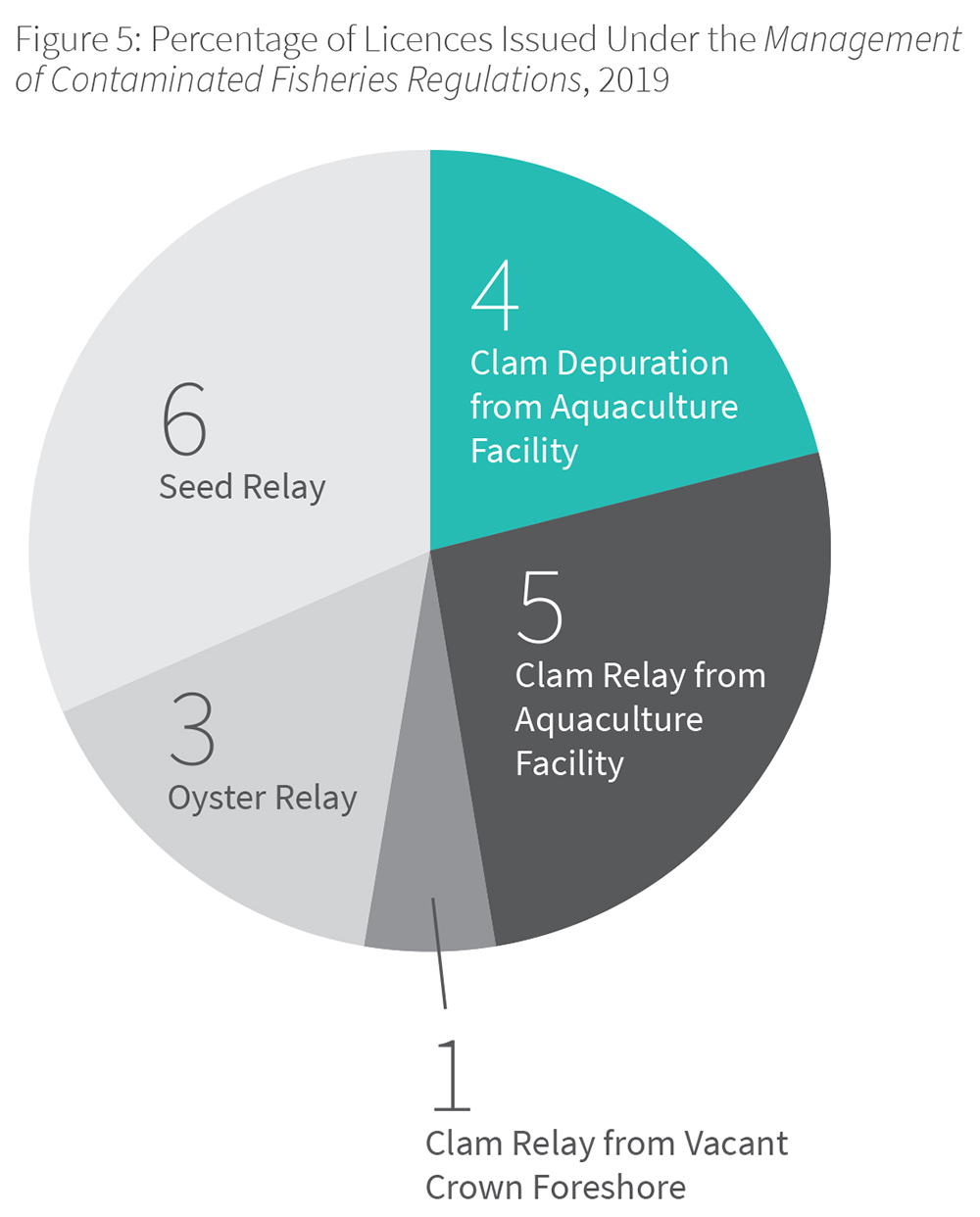
Long text version
- Clam relay from vacant crown foreshore: 1%
- Oyster relay: 3%
- Seed relay: 6%
- Clam depuration from aquaculture facility: 4%
- Clam relay from aquaculture facility: 5%
| 2019 | ||||
|---|---|---|---|---|
| # | COL | Total | Non-compliant | |
| # | # | % | ||
| 1 | Part 1
10. Requirement for the licence holder to make a contaminated shellfish harvest notification prior to the commencement of a harvest:(1) A minimum of 24 hours prior to commencing a harvest, the licence holder shall:(a) submit a Harvest Notification in writing. The Harvest Notification shall be complete and accurate. The format for the Harvest Notification may be obtained from DFO.Depuration.MPO@dfo-mpo.gc.ca The Harvest Notification shall be submitted to:
|
104 | 6 | 6% |
| 2 | Part 1
10. Requirement for the licence holder to make a Contaminated Shellfish Harvest Notification prior to the commencement of a harvest:(1) A minimum of 24 hours prior to commencing a harvest, the licence holder shall: (b) The Harvest Notification for all harvest sites shall provide the following information:(b) The Harvest Notification for all harvest sites shall provide the following information:
|
104 | 29 | 28% |
As a requirement of MCFR licences (with the exception of most facilities licensed for seed relay), licence holders must submit a notification to DFO a minimum of 24 hours before a planned harvest. This notification provides important information on the timing and source/ destination locations for harvests in contaminated areas. An audit of one hundred and four notifications submitted for harvests under the MCFR in 2019, revealed that 72% met the requirements of being complete, free of errors, and submitted on time (Table 3).
Annual Aquaculture Statistical Report (AASR)
DFO requires aquaculture licence holders to submit information on their operations including harvest for food market sales, processing, sales for restocking or on-growing purposes, stock on hand, future plans and subtidal shellfish seeding activities. This information is provided through the Annual Aquaculture Statistical Report (AASR). Shellfish aquaculture licence holders must submit AASR reports to the Department annually, on or before January 25 of the following year (Figure 6).
The information in the AASRs is used by DFO for analytical and operational purposes and assists DFO, the Canadian Food and Inspection Agency (CFIA), the Province of BC, First Nations,industry, and stakeholders to better understand the activities of the aquaculture industry and to analyze trends over time. Harvest data can be used to inform managers of the area-based intensity of aquaculture in BC and can be used with environmental data to allow better understanding of the environmental pressures and impacts of aquaculture activities. This in turn allows for sustainable management of the industry, supports policy development, and contributes to decision making processes for new aquaculture licences or amendments to existing licences. Accurate and timely AASR data collection and reporting is critical to responsible, accountable, and transparent decision making for the proper management and control of this fishery.
Aquaculture Activities Regulations (AAR) Reports
The national Aquaculture Activities Regulations (AAR) clarify conditions across Canada under which aquaculture operators may install, operate, maintain, or remove an aquaculture facility; undertake measures to treat their fish for disease and parasites; and deposit organic matter under sections 35 and 36 of the Fisheries Act. The AAR allow aquaculture operators to do so within specific restrictions to avoid, minimize, and mitigate any potential detriments to fish and fish habitat. The AAR also imposes specific environmental monitoring and sampling requirements on industry. Licence holders are required to submit annual reports on their activities no later than April 1 each year (Figure 7). For more information on the AAR, please visit the our website.
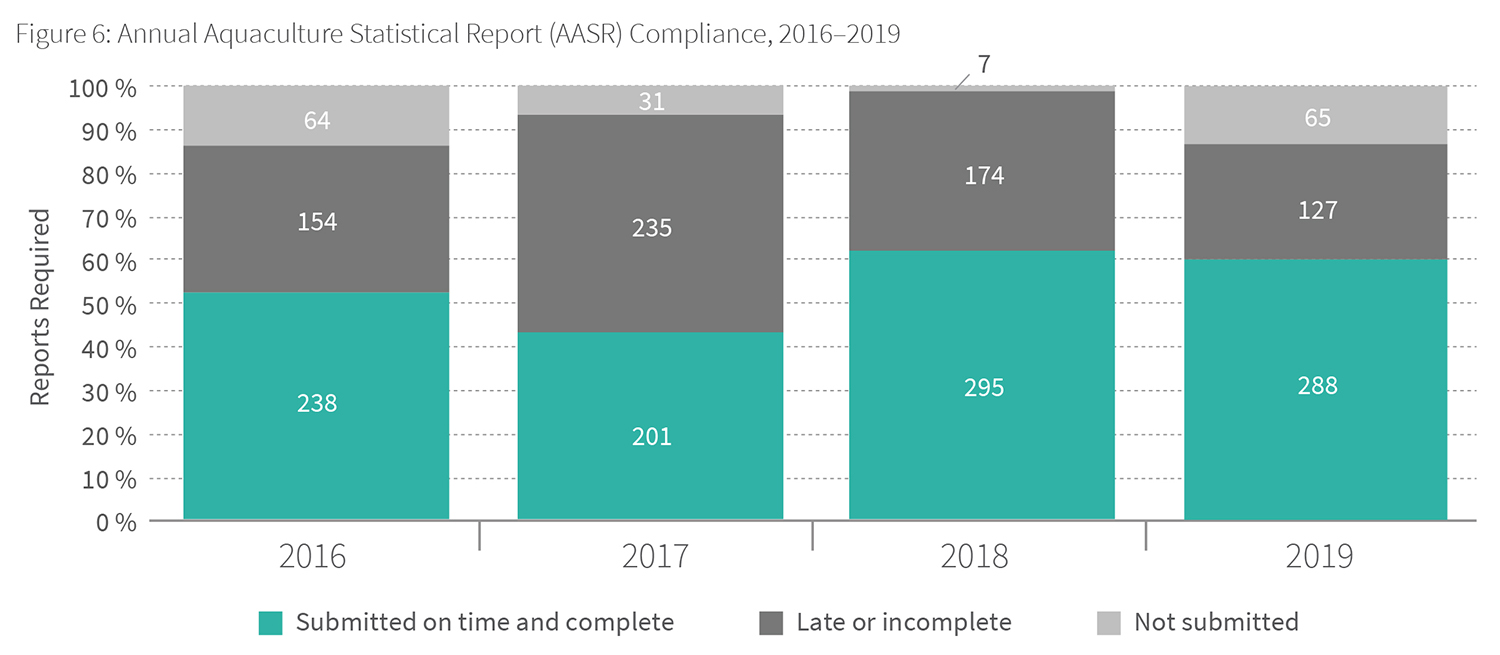
Long text version
| Year | Submitted on time and complete | Late or incomplete | Not submitted |
|---|---|---|---|
| 2016 | 238 | 154 | 64 |
| 2017 | 201 | 235 | 31 |
| 2018 | 295 | 174 | 7 |
| 2019 | 387 | 55 | 42 |
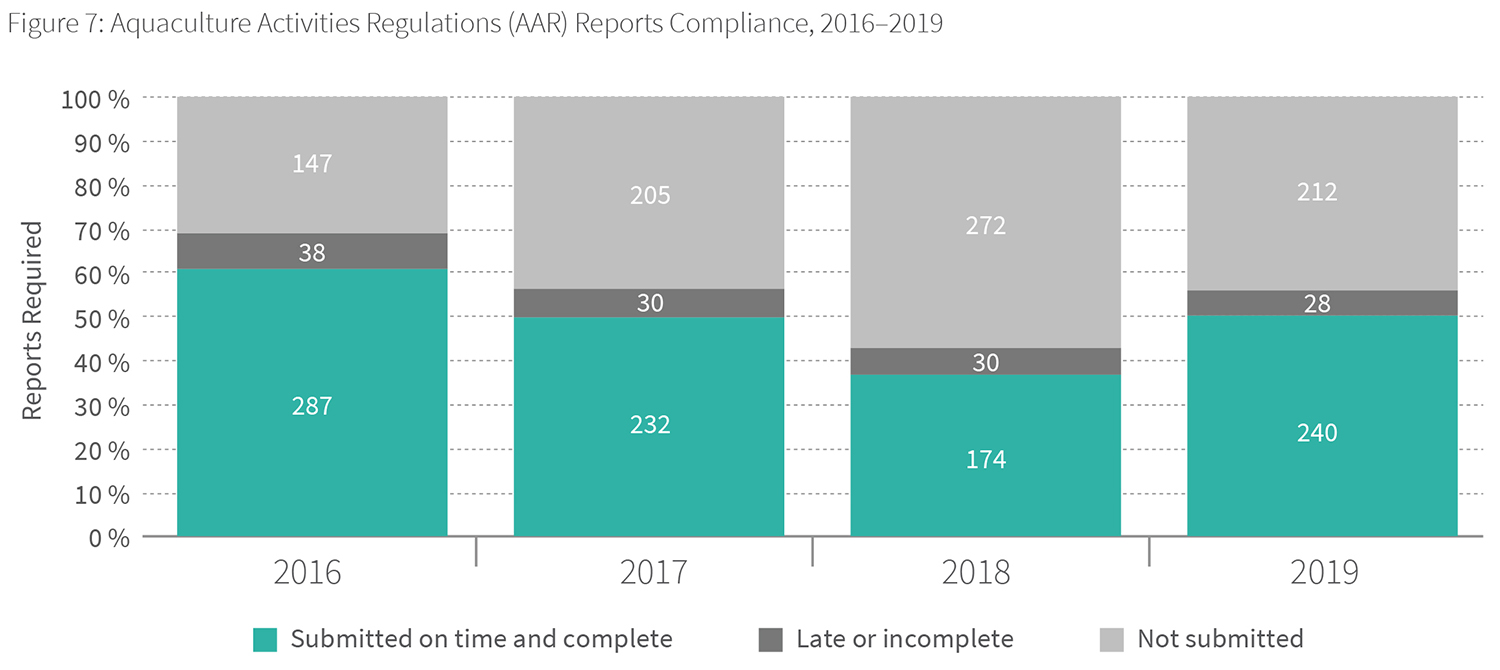
Long text version
| Year | Submitted on time and complete | Late or incomplete | Not submitted |
|---|---|---|---|
| 2016 | 287 | 38 | 147 |
| 2017 | 232 | 30 | 205 |
| 2018 | 174 | 30 | 272 |
| 2019 | 240 | 28 | 212 |
Aquaculture licence fees
Aquaculture licence fees were implemented in 2015 to align with the requirements of other provinces, ensure consistency, and limit any undue competitive advantage (Table 4). In developing the proposed fees, DFO considered factors such as allowable production volume, size of operations, and ease of administration.
Aquaculture licence fees have two elements:
- A flat administrative fee applied to partially recover administrative processing and licence issuance costs. The flat fee is charged when a licence is issued for a new site, when licences are renewed, and for changes of ownership.
- An access-to-resource fee for use of the waters for aquaculture purposes. The access to resource fee is meant to reflect the impact and economic benefit from using the public resource to conduct business and collect revenues. Fees are charged based on the size of the aquaculture tenure.
| 2017 | 2018 | 2019 | |
|---|---|---|---|
| Access to resource fees (per hectare of the licensed area) | $5.20 | $5.30 | $5.40 |
| Administrative fee | $104.00 | $106.00 | $108.00 |
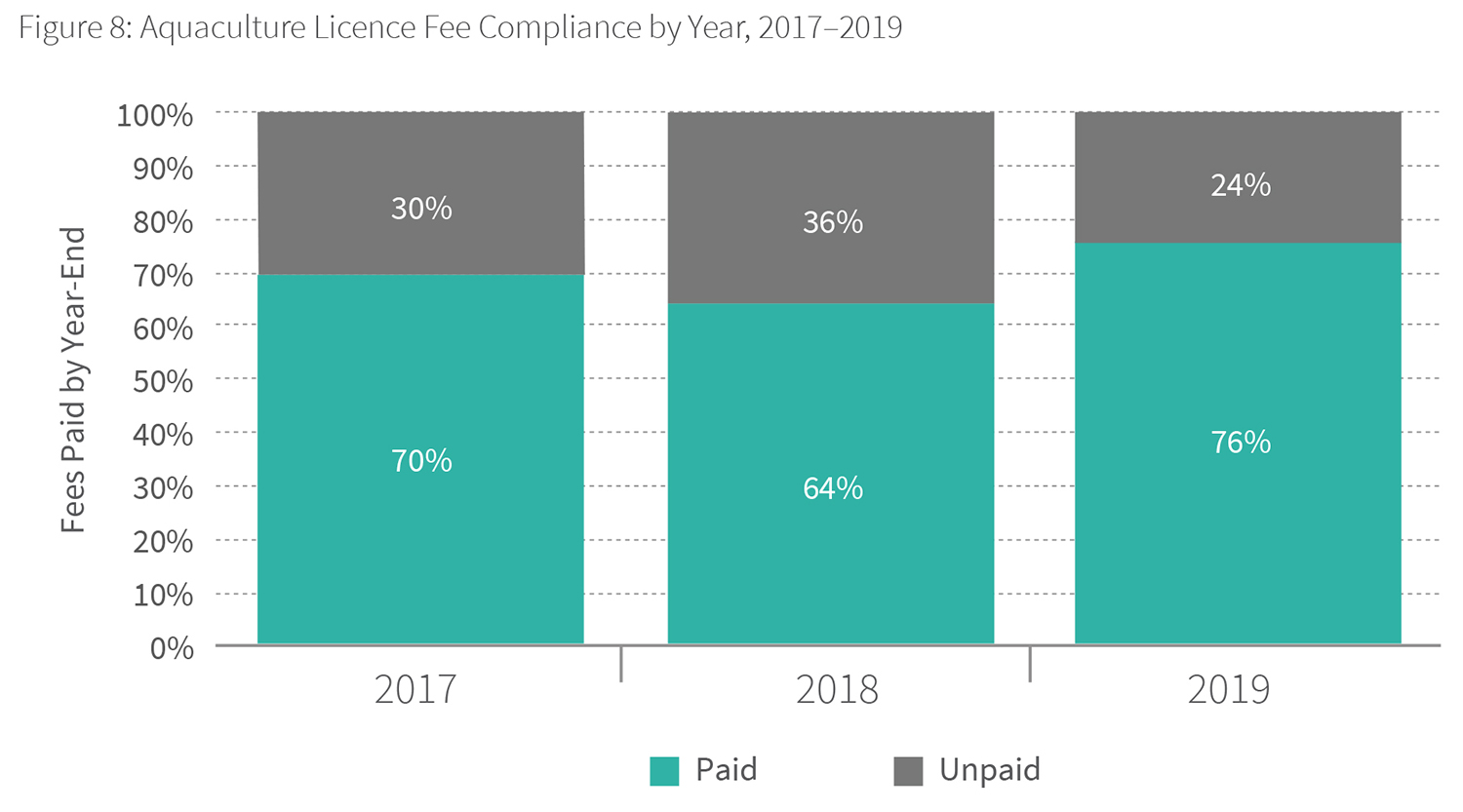
Long text version
| Year | Paid | Unpaid |
|---|---|---|
| 2017 | 70% | 30% |
| 2018 | 64% | 36% |
| 2019 | 76% | 24% |
Licence holders must pay applicable fees before the end of the year in which the fee was issued (Figure 8). For more information on shellfish aquaculture licensing in BC, including user fees, please visit our aquaculture licence webpage or contact the Pacific Aquaculture Licensing Unit by email at aquaculture.licensing@dfo-mpo.gc.ca.
Introductions and transfers and access to wild aquatic resources licences
The joint federal/provincial British Columbia Introductions and Transfers Committee (BC ITC) is responsible for reviewing proposals for both aquaculture and non-aquaculture related movements of shellfish into and between zones within BC and makes science-based recommendations for acceptance or rejection of an application. The National Code on Introductions and Transfers of Aquatic Organisms provides the terms of reference for ITCs to assess proposals to move aquatic organisms from one water body to another. It also provides a consistent process for assessing the potential impacts of intentional introductions and transfers of aquatic organisms. Aquaculture Management, through the BC ITC, also reviews applications and issues licences for access to wild aquatic resources for aquaculture purposes according to the national policy on Access to Wild Aquatic Resources As it Applies to Aquaculture. This policy provides the aquaculture industry with access to wild stocks in a manner that is consistent with the Department's sustainable management of those stocks.
Most shellfish access licences are issued for geoduck broodstock or Pacific oyster spat collection. In 2019, access to oyster spat collection was restricted due to concerns regarding debris and compliance from this activity. More work on this issue, and next steps, will be undertaken in 2020. While the long-term goal of the aquaculture industry is to minimize the requirement for access to wild stock for culture purposes, for species where hatchery production technology does not exist or where the cost of hatchery production is prohibitive, access to wild stocks is essential to the development and expansion of the aquaculture industry.
ITC and access licence holders must complete a record of transfer form and submit it to the Department no later than 30 days after completion of the transfer activity (Figure 9).
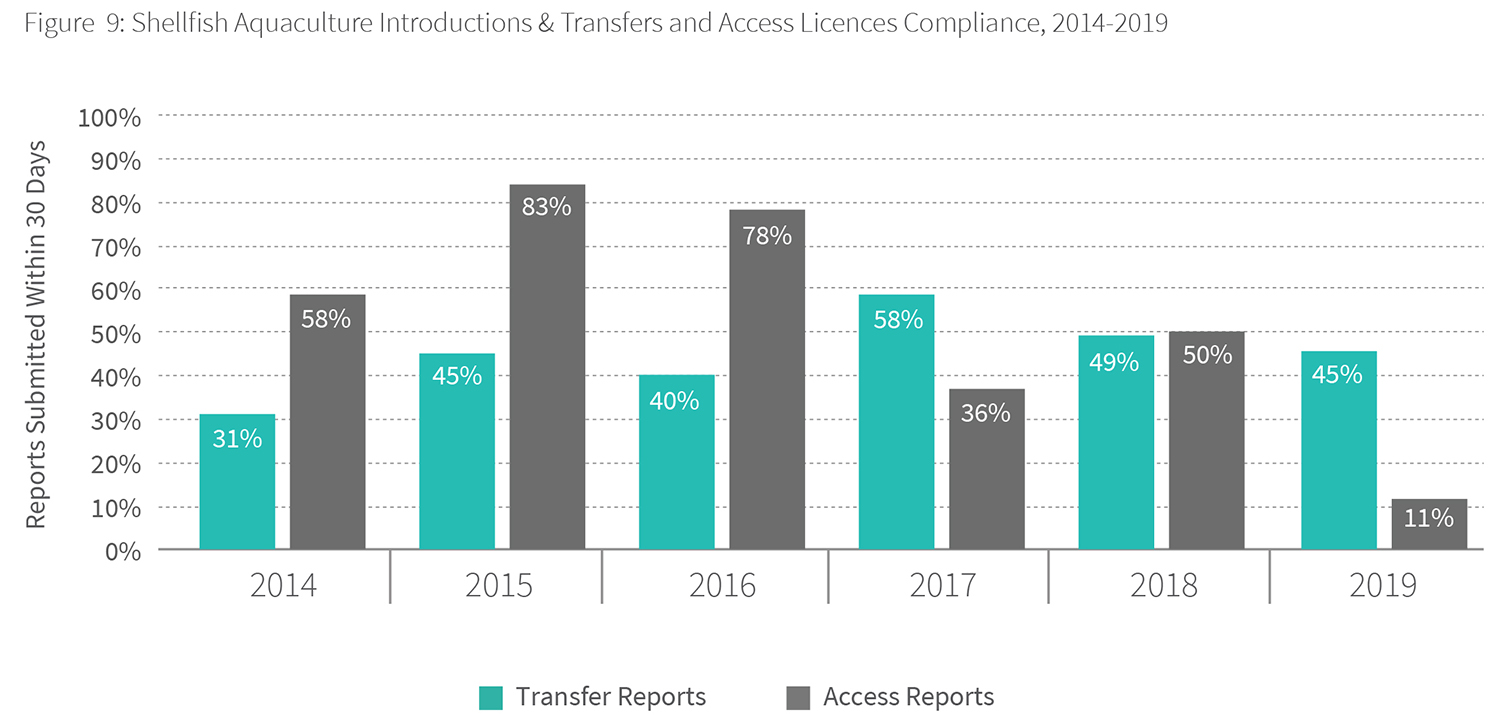
Long text version
| Year | Transfer reports | Access reports |
|---|---|---|
| 2014 | 31% | 58% |
| 2015 | 45% | 83% |
| 2016 | 40% | 78% |
| 2017 | 58% | 36% |
| 2018 | 49% | 50% |
| 2019 | 45% | 11% |
Enforcement
Fisheries and Oceans Canada (DFO) works closely with various federal, provincial, territorial, and international organizations to execute its mandate of protection of fish and fish habitat and managing aquaculture. DFO also relies on the involvement of Indigenous fishing associations and groups, industry, recreational fishers and the public. If a significant compliance issue is identified, the file is referred to DFO's Conservation and Protection (C&P) division. C&P promotes and maintains compliance with legislation, regulations, and fishery management measures to support the conservation and sustainable use of Canada's aquatic resources and the protection of species at risk, fish habitat, and oceans.
Fishery officers and fishery guardians (biologists) are responsible for conducting inspections and verifying compliance with the Fisheries Act, the Fishery (General) Regulations, the Pacific Aquaculture Regulations, and the Aquaculture Activities Regulations as they pertain to the aquaculture industry in BC. Fishery officers are responsible for investigating violations. Reports, complaints, and discoveries of potential violations are recorded by fishery officers as "occurrences" and must be investigated before enforcement action is taken. The response is determined based on the severity of the violation.
There are a range of compliance and enforcement options available:
Education
Education and outreach to licence holders is used as the initial approach to promote compliance and mitigation measures and ensure licence holders understand their conditions of licence. This includes verbal communications with licence holders to explain and describe compliance requirements, written documents and communications tools, and participation in various conferences, seminars and working groups.
Warnings
When minor violations occur, warning letters form part of the permanent compliance record for the individual or company. Follow-up inspections and corrective measures, such as site clean-up, may be required.
Charges
An individual or company may face formal charges laid in court for one or more violations. The Fisheries Act allows a maximum penalty of a $100,000 fine and/or one year in jail for summary convictions and a $500,000 fine and/ or two years in jail for an indictable conviction. Extra costs may also be imposed and seized items may be forfeited.
Restorative justice
In some cases, the accused will be offered the opportunity to engage in alternative measures or a restorative justice process instead of proceeding to court. Restorative justice is designed to address offending behaviour and conflict in a formally recognized dispute resolution process which may include participation from a community. Restorative justice may take place before or after charges are laid.
Fishery officer activity and enforcement
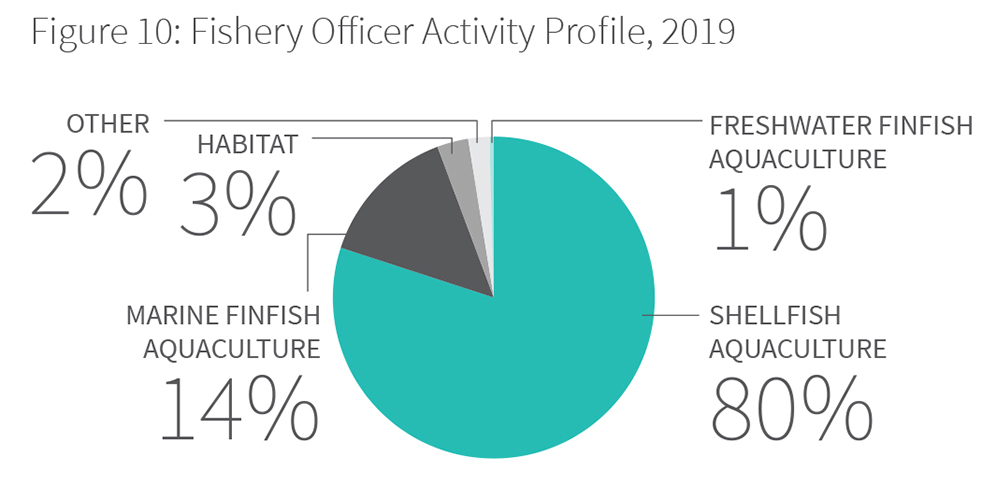
Long text version
| Other | 2% |
| Habitat | 3% |
| Freshwater finfish aquaculture | 1% |
| Marine finfish aquaculture | 14% |
| Shellfish aquaculture | 80% |
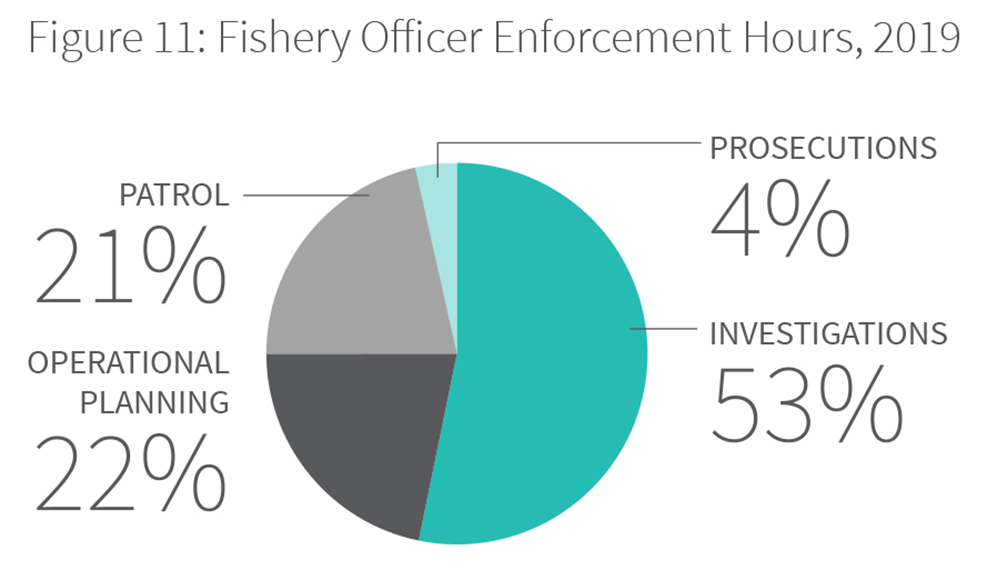
Long text version
| Patrol | 21% |
| Prosectutions | 4% |
| Operational planning | 22% |
| Investigations | 53% |
In 2019, C&P continued to dedicate significant efforts towards addressing traceability and non- compliance concerns in the shellfish aquaculture sector (Figure 10 and 11). Fishery officers worked to address significant violation files and continued non-compliance of annual reporting by some licence holders. Reports of harvests and sales, obtained through Annual Aquaculture Statistical Reports (AASRs), can be used to identify potential illegal harvests or laundering of wild shellfish through aquaculture facilities. For that reason, demand notices for missing report information were issued and AASRs were heavily reviewed.
Public complaints
DFO receives public complaints relating to aquaculture through the Observe, Record, Report (ORR) phone line. The reports primarily involve derelict or lost gear, degraded foam from unwrapped floatation gear, and issues with unmaintained netting and predator deterrent equipment. One warning was issued to a license holder for inappropriate operation of heavy equipment in the intertidal environment.
Summary of violations, charges, and convictions
In 2019, violations associated with tagging, record-keeping, unlawful harvest, AASR reporting, unlawful wet storage and transfers of shell stock, and habitat destruction were investigated. A total of 67 occurrences were recorded by C&P, including:
- 42 AASR irregularities or violations
- 11 miscellaneous harvest and condition of licence occurrences
- 8 miscellaneous reported occurrences
- 4 habitat and unlawful debris/derelict gear occurrences
- 2 obstruction concerns
From these occurrences, the following 45 violations were addressed:
- 36 warning letters issued for AASR violations
- 2 warning letters for other shellfish aquaculture licence condition violations
- 7 files are still under investigation
Charges were sought in four cases of significant violations discovered following a review of the conditions of licence section 12 requirements. These violations included failing to tag products, failing to land products at federally registered plants and false report returns. Results of recommended charges are pending.
No convictions were reported for 2019, though several major cases involving conditions of licence violations and false information returns from previous years remained under ongoing investigation. Environmental habitat concerns and human health related risks stemming from condition of licence violations remained high concerns.
Looking forward
Fisheries and Oceans Canada (DFO) has increased its focus on the risks related to shellfish aquaculture and has identified several key areas of work to improve performance in the sector.
Environmental protection
In 2020, the Department will continue to take actions to advance Canada's commitments under the G7 Ocean Plastics Charter, specifically addressing debris from the fishing and aquaculture sectors. The Government of Canada is investing in local businesses and their technology to better process end-of-life plastic gear from the aquaculture industry. This effort intends to assist the industry with remediation of debris issues. DFO will continue to advance innovative methods to deal with marine debris and environmental protection via:
- outreach and education
- collaborative projects with industry, First Nations and stakeholders; and
- seeking out new compliance & enforcement tools
The Ghost Gear Fund was first announced by the Prime Minister in July 2019. This fund supports Canadians in their actions to reduce abandoned, lost or otherwise discarded fishing gear, also known as ghost gear. The program offers $8.3 million over 2 years (2020-2022) to support projects that fall under four themes:
- Ghost gear retrieval
- Responsible disposal
- Acquisition and piloting of currently available innovative gear technology
- International leadership
Applications are expected to open in January 2020 and shellfish growers and their associations have been encouraged to apply.
Human health and traceability
DFO is committed to collaborating with its Canadian Shellfish Sanitation Program (CSSP) partners, First Nations, and stakeholders to ensure that shellfish product harvested from BC waters is safe for consumers. To further support this objective, the Aquaculture Management Division and Conservation and Protection will be focusing on advancing the Bivalve Traceability Initiative. The Bivalve Traceability Action Plan will include targeted enforcement, follow-up of investigations currently underway, ongoing auditing of records, reports and notifications to support traceability, and implemention of new management measures to address gaps and key findings.
These issues involve multiple regulatory bodies, industry members, First Nations, and the public. DFO will continue engagement with these groups to facilitate shared solutions to traceability challenges.
Aquaculture grants and contributions
While not exclusively for the aquaculture sector, DFO finances initiatives to support, promote, and improve sustainability of the industry under national and regional grants and contributions programs like:
- Fisheries and Aquaculture Clean Technology Adoption Program (FACTAP);
- Pacific Integrated Commercial Fisheries Initiative (PICFI); and
- British Columbia Salmon Restoration and Innovation Fund (BCSRIF)
Shellfish aquaculture initiatives can qualify for these programs, which may include collaborative studies, research projects, support for development of innovations, community outreach and capacity building, and promotion of the departmental mandate.
Fisheries and Aquaculture Clean Technology Adoption Program
Fisheries and Aquaculture Clean Technology Adoption Program (FACTAP) is a national contribution program investing $20 million over four years (2017 to 2021) to assist Canada's fisheries, aquaculture, and seafood processing industries in improving their environmental performance. The program offers funding to eligible participants to implement market-ready clean technologies, processes, and sustainable practices into their day-to-day operations (Figure 12). Eligible projects receive funding for up to 75% of project costs. All project proposals submitted for consideration must also include:
- a minimum of 10% cash financial commitment by the applicant; and
- at least 10% confirmed provincial or territorial government support in cash or in-kind.
Applicants may also seek an additional 5% funding support from other government departments.
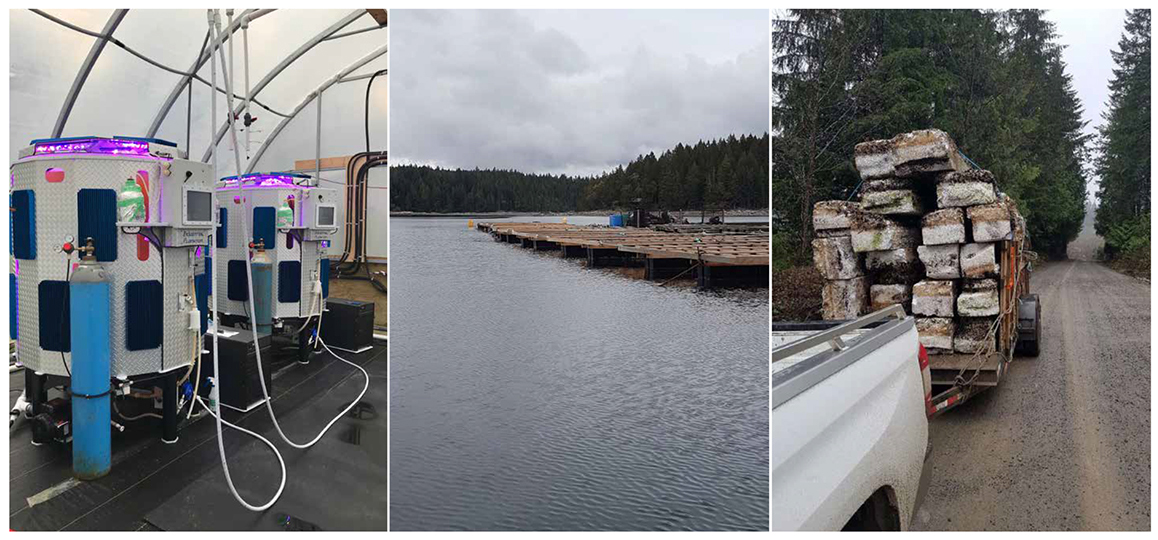
A list of projects funded by the FACTAP is available on our website. In 2019, 18 projects were approved in the Pacific Region at a value of over $2.3 million. The BC Ministry of Agriculture also supported over $330,000 towards these projects. Over $800,000 was contributed towards projects benefitting the shellfish aquaculture industry.
Pacific Integrated Commercial Fisheries Initiative
The Pacific Integrated Commercial Fisheries Initiative (PICFI) provides monetary support to Indigenous groups and communities in BC to maximize the potential of their communal commercial fishing enterprises and strengthen community economic self-sufficiency within the framework of an orderly, stable, integrated commercial fishery. The objective of the program is to develop self-sustaining Commercial Fishing Enterprises (CFEs), whereby eligible Indigenous groups are fully capable of taking complete ownership of fisheries operations and becoming successful, self-sustaining harvesters. DFO provides commercial fisheries with the access, business management capacity, and training needed to build self-sustaining Indigenous-owned commercial fishing enterprises. One of the key long- term objectives is for CFEs is to be able to generate spin-off business opportunities and increased employment in their communities. In 2019, 17 of the 65 applications received were aquaculture related, the majority of which were from the shellfish industry. Seven of these were applications successfully funded for a total of approximately $1.2 million.
There are three elements of the PICFI program which are:
- Capacity building
- Business development
- Aquaculture development
In addition, the PICFI Aquaculture Development Source (ADS) was created to provide direct support to First Nations to develop sustainable aquaculture operations. The application process is open to First Nations in the Pacific Region that currently do not participate in PICFI, as well as individual shareholder Nations of CFEs. Applications received directly from CFEs will not be eligible, as funding for similar activities are available through other PICFI funding streams (i.e. Business Development Source funding). More information is available on our PICFI website.
British Columbia Salmon Restoration and Innovation Fund
The British Columbia Salmon Restoration and Innovation Fund (BCSRIF) is intended to ensure the fish and seafood sector in BC is positioned for long-term environmental and economic sustainability. This joint federal/provincial fund supports the protection and restoration of wild Pacific salmon and other BC fish stocks through:
BCSRIF had an application intake in 2019 and another is planned for 2020. Funding is available to support project activities until March 31, 2024. More information on BCSRIF can be found on our website.
- Date modified: